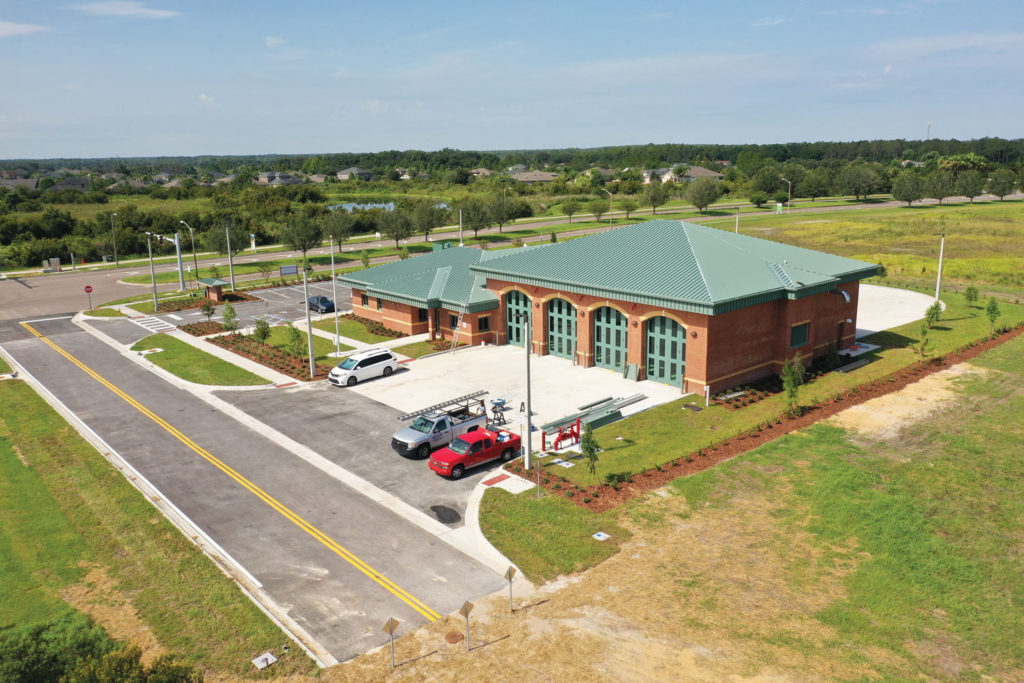
For the second time this year, Wesley Chapel will soon be celebrating the Grand Opening of a newly-equipped fire rescue station, bringing the total to three stations that are currently serving one of the county’s fastest-growing areas.
Although Pasco County Fire Rescue (PFR) Station No. 38, located in WaterGrass (west of Curley Rd.), has been staffed and operational since last week, the official ribbon cutting is expected to take place in early August, heralding the arrival of one of the largest and most high-tech Pasco fire stations around.
“We have a group of citizens that live in that area and have followed this project for the last five years,” said Pasco fire chief Scott Cassin. “I’m sure they are very excited to see the station open — as are we.”
Station No. 38 will join No. 26, which is located on Aronwood Dr. in Meadow Pointe, and No. 13, which is located off of Old Pasco Rd. The all-new Station 13 opened after an extensive expansion, renovation and relocation earlier this year.
Fire Station 38 is a 10,843-sq.-ft. facility, with four drive-through bays, versus the standard two or three bays that most other PFR stations have.
The size of the station will help it expand to meet the needs of existing communities like WaterGrass and Epperson, as they continue to add thousands of new homes to the area.
On day one, Station 38 opened with a fire engine truck, as well as one of only two air trucks — or light and air units, which provide supplemental lighting and SBCA air bottles at the scene of emergencies — in the county (there is another one that serves the west side of Pasco).
The new station also will house an EMS unit and (by December) an ambulance crew will be stationed there as well, or maybe a ladder truck, special operations team or even a hazmat team.
“We’ve built the building with that expandable capacity in mind,” Chief Cassin says. “(Wesley Chapel) is going to continue to grow, and we’ve built a facility big enough that we can expand in the future and meet those future needs.”
A new PURVIS alert system has been integrated into the new building to help speed up response times. The current analog system, which sends out loud signals from dispatch via bell or alert tones, is being replaced with a digital system that Cassin says will produce better results.
The well-known, loud screeching sounds will be replaced by a series of tones that gradually increase in volume, “Which is really nice at 3 in the morning when you are asleep and you get a call,” Chief Cassin says, chuckling. “Now you have to peel me off the ceiling because it’s so loud it scares you. This is much more gentle on the cardio vascular system.”
Alerts also can be targeted toward only the firefighters needed for a particular call, and not the entire station.
Lights will help alert firefighters about how much time has elapsed. They are expected to be out of the station within 60 seconds, and the lights will change colors as time passes.
There also are display monitors that firefighters can use as a guide, and in the bay is a “rip and run,” which is a back-up printout of the call, in case the computer in the truck goes down.”
Another nice addition to the new system — it can alert all of the necessary fire stations at the same time. Currently, on calls that require more than one apparatus, the dispatch center has to call each individual station, in order of their proximity to the call or they type of equipment they have.
“With the new system, one push of the button will alert all the stations at the same time,” Cassin says. “It will shave off time. Even if it’s only 10 seconds, it’s still 10 seconds. It can make the difference.”
Those working in the station will be beneficiaries of a new Plymovent diesel exhaust capture system. Long yellow tubes will be connected to the exhaust pipes of the fire vehicles, so that when the vehicle is started in the bay, the discharge of diesel exhaust (carbon monoxide and the carcinogen Benzene) is collected into the system and evacuated to outside air.
When the truck leaves, the tubes, connected by a system of magnets, detach at a certain point.
“We’re going to have very very clean air at that station (and reduce the cancer risk),” Cassin says. “We’re working on a plan to retrofit the rest of our stations with that system.”
The new station at WaterGrass helps fulfill PFR’s goal of having a station within five miles of every structure. Until No. 38 came along, those in WaterGrass and the surrounding area were outside that range — more than 8 miles from No. 13 and 10 miles from No. 26.
Cassin says not only does the station provide safety benefits, but homeowners should receive a premium reduction if they alert their homeowners insurance companies that a new station has opened close to their homes.
Station No. 38 won’t be the last fire station for Wesley Chapel, which continues to grow unabated. Cassin says a station already is funded for the north end of Meadow Pointe at S.R. 54 — the land still needs to be purchased — with plans to build in 2022. And, Cassin says, the I-75 and S.R. 56 area currently is being studied as a future site as well.




No comment yet, add your voice below!